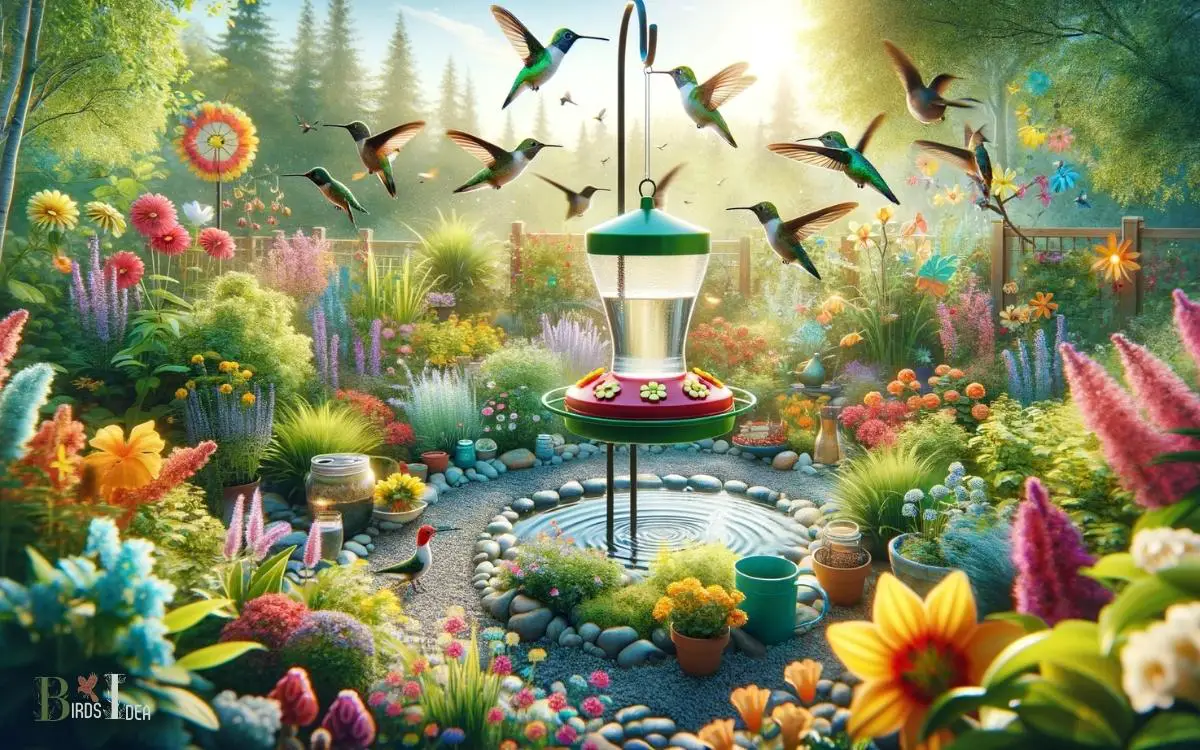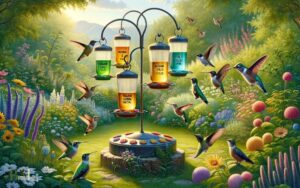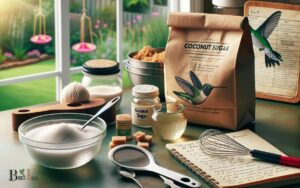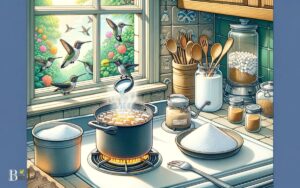How to Attract Hummingbirds to a Hummingbird Feeder? 5 Steps
Discover how to attract hummingbirds to your garden by choosing the right hummingbird feeder, preparing homemade nectar, and creating a bird-friendly habitat.
Attracting hummingbirds involves several key steps:
Create a mesmerizing retreat for hummingbirds with the right feeder and a garden full of blooms.

Key Takeaway
Step 1: Choosing the Right Feeder Location
To effectively cater to the territorial nature of hummingbirds, it is essential to carefully choose the location of the feeder.
Opt for a spot that provides a clear view of the surroundings, allowing the hummingbirds to easily detect any potential threats.
Select an area with some overhead coverage, such as tree branches, to offer protection from rain and direct sunlight.
Positioning the feeder near flowers, shrubs, or trees can also create a natural and inviting environment for the hummingbirds.
Ensure that the chosen location is easily accessible for refilling and cleaning, as this will facilitate regular maintenance and upkeep.
By strategically placing the feeder in a suitable location, you can attract and serve these delightful birds while respecting their natural instincts and behaviors.
Step 2: Selecting the Best Feeder Type
When it comes to attracting hummingbirds to a feeder, the design of the feeder plays a crucial role.
Factors such as the feeder’s color, shape, and the presence of perches can significantly impact its attractiveness to hummingbirds.
Considering the placement of the feeder within the landscape can further enhance its appeal to these beautiful and agile creatures.
Feeder Design Matters
The selection of the appropriate feeder type is crucial for attracting hummingbirds to your feeder. When choosing a feeder, opt for designs that prioritize the birds’ comfort and safety.
Look for feeders with perches to allow the birds to rest while feeding, and consider those with bee guards to prevent bees and other insects from accessing the nectar.
Moreover, selecting a feeder with a built-in ant moat can help deter ants from reaching the nectar, ensuring a clean and safe environment for the hummingbirds.
Choosing a feeder with bright, eye-catching colors can attract hummingbirds from a distance.
By prioritizing the birds’ needs and safety in the feeder design, you can create an inviting and comfortable feeding station that will attract and serve these delightful creatures.
Step 3: Using the Ideal Nectar Solution
When it comes to attracting hummingbirds to a feeder, using the ideal nectar solution is essential.
This includes preparing a suitable nectar recipe, selecting the right feeder nectar, and maintaining the nectar to ensure it remains fresh and safe for hummingbirds.
By understanding these key points, you can effectively attract and provide for these delightful birds in your garden or outdoor space.
Nectar Recipe for Hummingbirds
To prepare the ideal nectar solution for hummingbirds, use a ratio of 1 part white granulated sugar to 4 parts water.
This simple recipe closely mimics the sucrose content of natural flower nectar, providing the energy hummingbirds need.
It’s crucial to use only white granulated sugar, as other sweeteners or artificial substitutes can be harmful to these delicate birds.
Boil the water first to help the sugar dissolve completely, then let the solution cool before filling the feeder. Any extra nectar can be stored in the refrigerator for up to one week.
Regularly cleaning the feeder and replacing the nectar every 3-4 days, or more frequently in hot weather, is essential to maintain the health of visiting hummingbirds.
By preparing and maintaining the nectar solution with care, you can provide a welcoming and nourishing environment for these beautiful creatures.
Choosing Feeder Nectar
The ideal nectar solution for attracting hummingbirds to a feeder consists of a ratio of 1 part white granulated sugar to 4 parts water.
When choosing feeder nectar, it’s important to consider the following:
- Use white granulated sugar: This type of sugar closely resembles the nectar found in flowers and is easily digestible for hummingbirds.
- Avoid using honey, brown sugar, or artificial sweeteners: These can be harmful to hummingbirds and may cause health issues.
- Boil the water: Boiling the water helps to remove impurities and ensures a clean nectar solution for the hummingbirds.
- Let the nectar cool before filling the feeder: Hot nectar can warp or damage the feeder, so it’s essential to allow it to cool to room temperature before filling the feeder.
Nectar Maintenance Tips
Proper maintenance of the nectar solution in a hummingbird feeder is essential for attracting and nourishing hummingbirds.
To ensure the well-being of these delightful creatures, it’s important to use the ideal nectar solution and keep it fresh.
Here’s a helpful guide to crafting the perfect nectar solution:
| Nectar Solution Ingredients | Ratio of Ingredients |
|---|---|
| White granulated sugar | 1 part |
| Water | 4 parts |
Step 4: Maintaining a Clean Feeder
Regularly cleaning the feeder is essential for attracting hummingbirds and preventing the growth of harmful bacteria.
Maintaining a clean feeder not only ensures the health of the hummingbirds but also enhances the effectiveness of the feeder in attracting these beautiful creatures.
Here are some tips to help you keep your hummingbird feeder clean and inviting:
- Clean the feeder with a solution of one part white vinegar to four parts water.
- Use a small brush or pipe cleaner to scrub the feeding ports and any other hard-to-reach areas.
- Rinse the feeder thoroughly with clean water after cleaning.
- Refill the feeder with fresh nectar regularly, and discard any leftover nectar after a few days.
Step 5: Adding Attractive Landscaping
To create an inviting environment for hummingbirds, consider incorporating attractive landscaping around the hummingbird feeder.
Planting colorful flowers such as bee balm, salvia, and trumpet vine can attract hummingbirds with their vibrant blooms and nectar.
These flowers not only add beauty to the surroundings but also provide a natural food source for the hummingbirds, enhancing the overall appeal of the feeding area.
Incorporating native plants and shrubs can further entice hummingbirds as they are naturally drawn to familiar flora.
Creating varied heights and layers of vegetation around the feeder can provide perches and shelter for the hummingbirds, making the area more attractive to them.
By carefully selecting and arranging plants around the feeder, you can significantly increase the chances of attracting these delightful birds to your garden.
Monitoring and Enjoying Hummingbird Activity
Monitoring and enjoying hummingbird activity can provide valuable insight into the effectiveness of the attractive landscaping in drawing these fascinating birds to the feeder.
Observing and keeping track of their behavior, as well as their visiting patterns, will help ensure a welcoming environment for these beautiful creatures.
Here are some tips to monitor and enjoy hummingbird activity:
- Keep a journal to record the times of day when hummingbirds visit the feeder
- Use binoculars for close-up observation without disturbing the birds
- Set up a camera or webcam to capture and review their visits
- Join a local birdwatching group to share experiences and learn from others
Why is it Important to Attract Hummingbirds to a Feeder Before Filling It?
Attracting hummingbirds to a feeder before filling it is crucial for successful feeding. To begin filling a hummingbird feeder in 6 steps, enticing the birds to the area ensures a higher likelihood of them discovering the food source. This pre-filling attraction not only increases the chances of them noticing the feeder promptly but also encourages their return visits.
Understanding Hummingbird Behavior
Hummingbirds exhibit territorial behavior, often defending feeding areas from intruders of their own species and other birds.
Understanding this behavior is crucial when trying to attract them to a hummingbird feeder. To cater to their territorial nature, it is advisable to place multiple feeders in different locations, ensuring that no single bird can dominate all the feeding spots.
Planting native flowers and providing perches can create a more inviting environment, as these elements mimic their natural habitats. It’s also important to keep the feeders clean and the nectar fresh, as hummingbirds are attracted to cleanliness.
By understanding and respecting their territorial behavior, individuals can create an environment that is more welcoming to hummingbirds, ultimately serving the needs of these fascinating creatures.
Conclusion
Attracting hummingbirds to a feeder requires understanding their behavior, choosing the right location and feeder type, using the ideal nectar solution, maintaining a clean feeder, and adding attractive landscaping.
By monitoring and enjoying hummingbird activity, you can create a welcoming environment for these fascinating creatures.
Despite the initial effort, the joy of watching hummingbirds visit your feeder and the beauty they bring to your surroundings make the process worthwhile.






